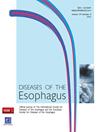474. MANOMETRIC IDENTIKIT OF A FUNCTIONING AND EFFECTIVE FUNDOPLICATION IN THE HIGH-RESOLUTION MANOMETRY ERA
IF 2.3
3区 医学
Q3 GASTROENTEROLOGY & HEPATOLOGY
引用次数: 0
Abstract
Assessing patients following Laparoscopic Fundoplication (LF) can be challenging. Functional information provided by pathophysiological testing—which can shed light on the cause of recurrent symptoms—could be key to clinical decision making. The value of performing High-Resolution Manometry (HRM) after LF is still unclear and debated. We sought to establish the HRM parameters indicative of a functioning fundoplication, and whether HRM could distinguish it from a tight or defective one. We studied patients with gastroesophageal reflux disease (GERD) who underwent laparoscopic Nissen (LN) or Toupet (LT) fundoplication between 2010–2022. HRM and pH monitoring were performed before and 6 months after surgery. LF failure was defined as GerdQ score ≥ 8 and abnormal 24 h-pH study or just abnormal 24 h-pH study. The study population was divided into 5 groups: LN and LT patients with normal pH monitoring (LNpH- and LTpH-, respectively); LN and LT patients with pathological pH monitoring (LNpH+ and LTpH+ groups, respectively); and patients with postoperative severe dysphagia (Dysphagia group). The novel Hiatal Morphology (HM) classification was applied, envisaging 3 subtypes: HM1 (normal morphology); HM2 (intrathoracic fundoplication); and HM3 (slipped fundoplication). We recruited 132 patients: 46 in the LNpH- group, 51 in the LTpH- group, 15 in the LNpH+ group, 7 in the LTpH+ group, and 5 in the Dysphagia group (Figure 1). Eight patients with GerdQ score ≥ 8 and normal 24 h-pH findings were excluded. At univariate analysis, postoperative lower esophageal sphincter (LES) basal pressure (p = 0.011), total and abdominal LES length (p = 0.014, p < 0.001) were correlated with LF failure. At multivariate analysis, postoperative abdominal LES length (p = 0.001) and HM2 (p < 0.001) were independently associated with surgical failure. Integrated relaxation pressure (IRP) was significantly higher in the Dysphagia group than in the LNpH- group. This study generated reference HRM values for an effective LF and confirms that using HRM to assess the abdominal portion of the neo-sphincter and abnormal hiatal morphology (HM2) improves the clinical assessment of recurrent symptoms. HRM can distinguish patients with a well-functioning wrap from those developing recurrent GERD due to an ineffective wrap. Postoperative IRP also correlated significantly with the onset of dysphagia after surgery.474. 在高分辨率测压时代,一种功能有效的测压方法
评估腹腔镜胃底折叠术(LF)后的患者可能具有挑战性。病理生理学测试提供的功能信息——可以揭示复发症状的原因——可能是临床决策的关键。LF术后进行高分辨率测压(HRM)的价值仍不清楚,也存在争议。我们试图建立指示功能性胃底折叠的HRM参数,以及HRM是否可以将其与紧密型或有缺陷型区分开来。我们研究了2010-2022年间接受腹腔镜Nissen(LN)或Toupet(LT)胃底折叠术的胃食管反流病(GERD)患者。术前和术后6个月进行HRM和pH监测。LF失败定义为GerdQ评分 ≥ 8和异常的24-h-pH研究或只是异常的24-h-pH研究。研究人群分为5组:LN和LT患者,pH监测正常(分别为LNpH-和LTpH-);进行病理pH监测的LN和LT患者(分别为LNpH+和LTpH+组);以及术后严重吞咽困难的患者(吞咽困难组)。应用新的Hiatal形态学(HM)分类,设想了3个亚型:HM1(正常形态学);HM2(胸内胃底折叠术);和HM3(滑底折叠术)。我们招募了132名患者:LNpH-组46名,LTpH-组51名,LNpH+组15名,LTpH+组7名,吞咽困难组5名(图1)。GerdQ评分的8名患者 ≥ 8和正常24小时pH的结果被排除在外。在单因素分析中,术后食管下括约肌(LES)基础压(p = 0.011)、总LES长度和腹部LES长度(p = 0.014,p < 0.001)与LF衰竭相关。在多变量分析中,术后腹部LES长度(p = 0.001)和HM2(p < 0.001)与手术失败独立相关。吞咽困难组的综合舒张压(IRP)明显高于LNpH组。这项研究产生了有效LF的参考HRM值,并证实使用HRM评估新括约肌腹部和异常裂孔形态(HM2)可以改善对复发症状的临床评估。HRM可以区分功能良好包裹的患者和因包裹无效而复发的GERD患者。术后IRP也与术后吞咽困难的发生显著相关。
本文章由计算机程序翻译,如有差异,请以英文原文为准。
求助全文
约1分钟内获得全文
求助全文
来源期刊

Diseases of the Esophagus
医学-胃肠肝病学
CiteScore
5.30
自引率
7.70%
发文量
568
审稿时长
6 months
期刊介绍:
Diseases of the Esophagus covers all aspects of the esophagus - etiology, investigation and diagnosis, and both medical and surgical treatment.
 求助内容:
求助内容: 应助结果提醒方式:
应助结果提醒方式:


